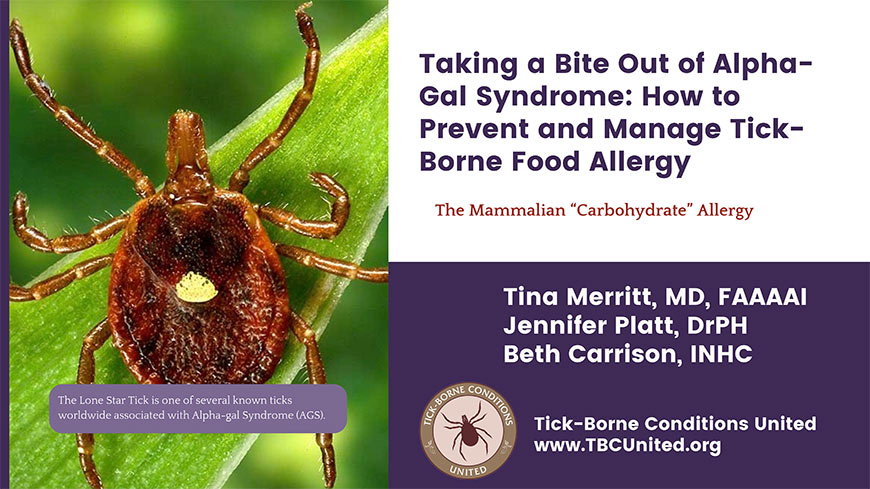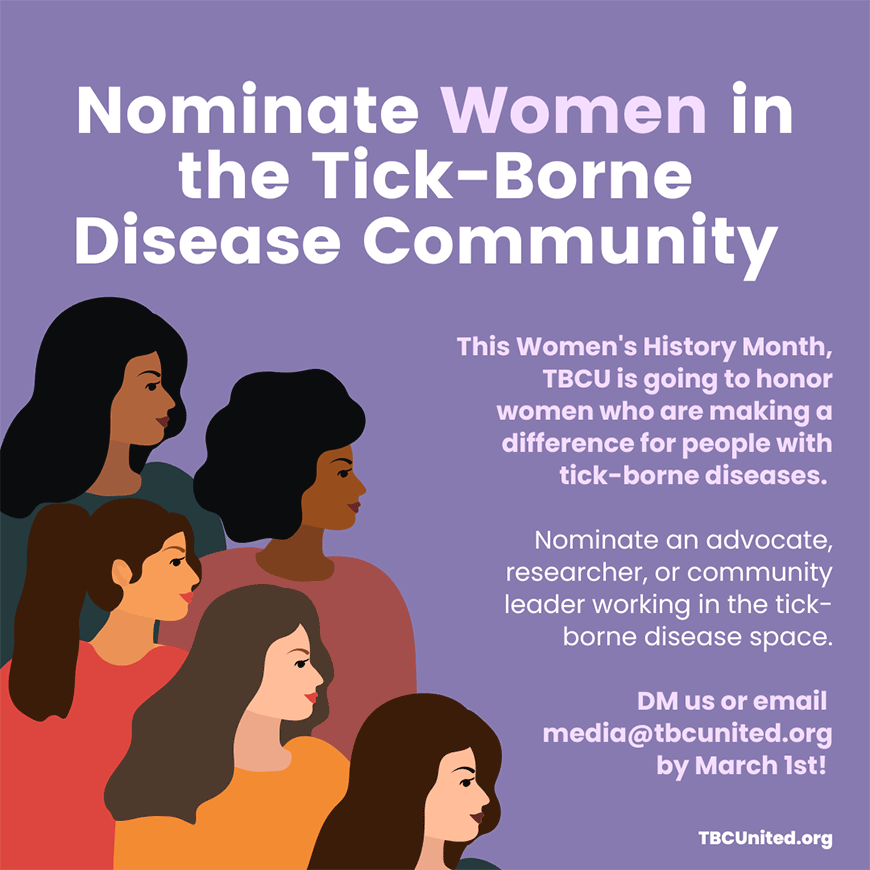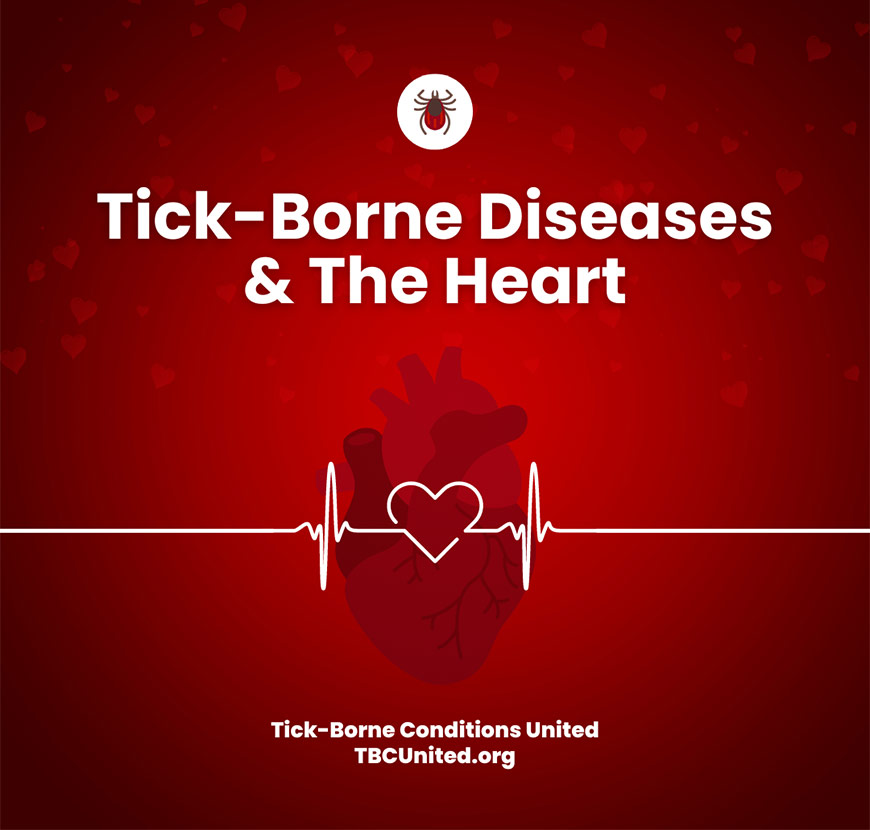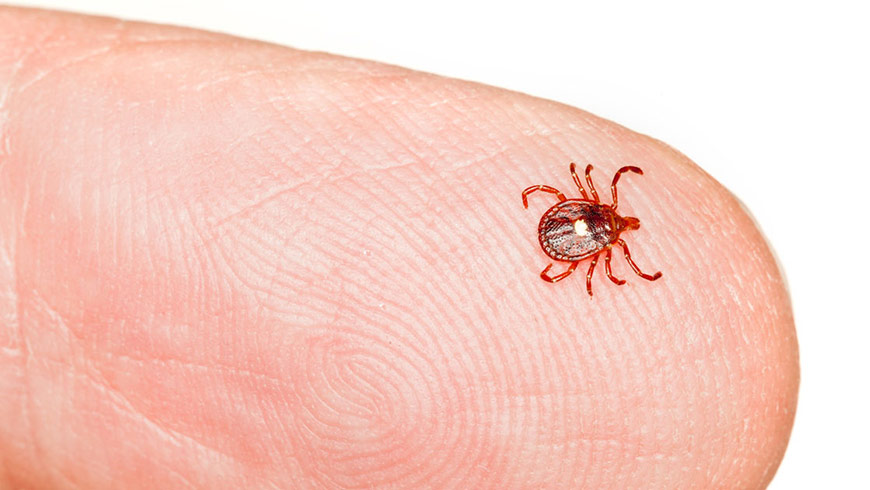Rocky Mountain Spotted Fever Information
2024 Alpha-gal Syndrome Symposium – Video Release
This symposium gathered some of the world's leading medical researchers,…
WEBINAR: Taking a Bite Out of Alpha-Gal Syndrome: How to Prevent and Manage Tick-Borne Food Allergy
Learn about diagnosis, testing, and key areas of support required…
Help Us Turn the AGS State Reporting Map Green!
Alpha-gal Activists! We need your help! On July 27, 2023,…
Nominate A Tick-Borne Disease Advocate for Women’s History Month
Women's History Month is just around the corner, and we…
Tick-Borne Diseases & The Heart
Tick-borne diseases can substantially impact heart health. Anaplasmosis and Ehrlichiosis…
Tick Bites Proven To Be Risk Factor for Alpha-gal Syndrome
It’s official! Patients with Alpha-gal Syndrome (AGS) have long suspected…
What are Rocky Mountain Spotted Fever (RMSF) and Other Spotted Fever Group (SFG) Rickettsioses?
Spotted fevers are caused by a group of similar bacteria whose members can be found on every inhabited continent. In the United States, several different bacteria have been found to cause spotted fevers. The bacterium Rickettsia rickettsii causes the deadliest of all tick borne diseases, Rocky Mountain Spotted Fever. Diseases caused by other bacteria, Rickettsia parkeri rickettsiosis and Pacific Coast Tick Fever (Rickettsia species 364D) are less severe than RMSF and are therefore more difficult to diagnose.
What are the Symptoms of RMSF?
The early symptoms of Rocky Mountain Spotted Fever arise 3-12 days after an infected tick bite. Two to four days after the fever begins, a rash forms in about 90% of patients. The early rash varies in appearance and only half of the patients develop a rash within the first three days.
Early symptoms (1-4 days)
- Fever;
- Headache;
- Muscle pain;
- Stomach pain;
- Nausea;
- Vomiting;
- Loss of appetite;
- Rash: in 90% of infections, 2-4 days after fever begins.
Late symptoms (5 days and later)
- Swelling of the brain leading to behavioral changes and coma;
- Multiorgan system damage including:
- Damage to blood vessels requiring amputation
- Difficulty breathing due to lung damage
- Kidney failure
- Death
What are the Symptoms of the Other Spotted Fever Group (SFG) Rickettsioses?
The first sign of a bite from ticks infected with other SFG bacteria is the formation of a dark scab, called an eschar. (Note: this does not happen in bites from R. rickettsii infected ticks). Subsequent symptoms — fever, aches, pains and rash — are similar to RMSF but are usually much less severe.
Who is at Risk for Developing a Spotted Fever Disease?
- Spotted fever diseases have been reported in every state in the continental US though over 60% of cases occur in North Carolina, Oklahoma, Arkansas, Tennessee, and Missouri.
- Native Americans have a higher incidence than any other group.
- Individuals with a glucose-6-phosphate dehydrogenase (G6PD) deficiency are more likely to develop a serious infection.
- Men are more likely to become infected than women.
- Most reported cases are in individuals over 40 years of age.
- Most reported deaths are in children less than 10 years old.
https://www.cdc.gov/rmsf/stats/index.html
When to See a Doctor
If you’ve been bitten by a tick or you’ve been exposed to areas where ticks live and have unexplained symptoms, contact your doctor. It is important to start treatment for spotted fever diseases as early as possible for them to be effective.
How Do I Get Tested and Diagnosed for Spotted Fever Group (SFG) Rickettsioses?
Inform your health care provider of your symptoms and that you have been bitten by a tick or spent time in areas where ticks can be found. Your provider may order blood and tissue tests to confirm the infection.
What are the Treatment Guidelines for Rocky Mountain Spotted Fever and Other SFG Rickettsioses?
If your health care provider thinks your illness may be caused by a SPG bacterium they should not wait for test results to confirm a diagnosis but should immediately recommend treatment with the antibiotic doxycycline.
For more information see https://www.cdc.gov/rmsf/healthcare-providers/treatment.html
How Can I Prevent SFG Rickettsioses?
The best way to prevent RMSF and other spotted fever diseases is to avoid tick-infested environments. Ticks are found in woody and bushy areas and anywhere deer travel or bed down. Additionally, use the following simple precautions:
For People:
- Use Repellents. Environmental Protection Agency (EPA)-registered insect repellents.
- Cover Up. Wear long, light-colored pants, tucked into socks. Long-sleeved, light-colored shirts, a hat, and gloves. Avoid grasses and leaf litter whenever possible.
- Treat Clothing and Gear with repellent such as undecanone, permethrin or buy pre-treated items.
- Perform Daily Tick Checks. Check yourself, your children, and your pets for ticks.
- Dry your clothes on high for 15 minutes after being outdoors in areas known for presence of ticks.
For Pets:
- Use Tick-Prevention. Talk to your veterinarian about recommended products.
- Perform Daily Tick Checks, especially after being outdoors.
- Remove ticks on your pet immediately. Avoid direct contact with your skin.
For Property:
- Tick-proof Your Yard. Clear brush and leaves where ticks live. Keep woodpiles in sunny areas. Use a yard spray to kill and repel ticks.
How Do I Remove a Tick?
- Remove a tick as soon as possible with sharp pointed tweezers.
- Grasp the tick at the point where it is embedded into the skin.
- Don’t squeeze or crush the tick, pull it carefully and steadily.
- Once you’ve removed the entire tick, save it in a plastic bag if possible for lab testing, and apply antiseptic to the bite area.

Source: Centers for Disease Control and Prevention.
Rocky Mountain Spotted Fever Information Resources Cited
Learn more about Rocky Mountain Spotted Fever, Rickettsiosis, and Other Spotted Fever Groups by accessing the following resources:
- Rocky Mountain Spotted Fever (RMSF): https://www.cdc.gov/rmsf/
- Epidemiology and Statistics | Rocky Mountain Spotted Fever (RMSF): https://www.cdc.gov/rmsf/stats/index.html
- Treatment | Rocky Mountain Spotted Fever (RMSF): https://www.cdc.gov/rmsf/healthcare-providers/treatment.html
- Other Spotted Fever Group Rickettsioses | Other Spotted Fevers: https://www.cdc.gov/otherspottedfever/index.html
This material is compiled from multiple respected sources, from TBC United research, and from the experiences of TBC United community members. While we work hard to ensure relevancy and currency, we cannot guarantee the accuracy of all information presented on this or associated (linked) web sites. The content is offered to provide practical and useful information on the subject matters covered. It is being presented with the understanding that TBC United is not engaged in rendering medical or other professional services. If medical or other expert assistance is required, the services of a licensed physician should be sought. If you choose to use preventive products on yourself, your loved ones, or your pets, carefully read and follow your medical professional and manufacturers’ recommendations.
Contact Us

Tell us how we can help.
Please provide your contact info and brief details and we’ll respond within one business day, or sooner.






